The prestigious biennial Royal Architectural Institute of Canada (RAIC) International Prize is not a typical architectural award.
An international jury of six highly distinguished architects has to choose a building that stands out for being “transformative within its societal context” and “expressive of the humanistic values of justice, respect, equality, and inclusiveness.” This they have to do from among an extraordinary selection of architectural structures from around the world that have impacted the social life of the communities within which they were built.

This year’s RAIC International Prize of $100,000 was awarded to the Bahá’í House of Worship for South America. The prize money is being dedicated to the long-term maintenance of the Temple. Commissioned by the Universal House of Justice and designed by Canadian architect Siamak Hariri, the House of Worship for South America has become an iconic symbol of unity for Santiago and well beyond. Overlooking the city from the foothills of the Andes, the Temple has received over 1.4 million visitors since its inauguration in October 2016. The House of Worship has not only symbolized unity but it has given expression to a powerful conviction that worship of the divine is intimately connected with service to humanity.
The connection between the built environment and the well-being of society was a preeminent concern for the Jury of the RAIC Prize. Diarmuid Nash, the Jury Chair, explains that three architectural projects were selected as finalists for the transformative impact they had on their respective communities. “The Bahá’í Temple was a community project. Numerous volunteers worked on this project, similar to a way a community project works in a small village, but this was on a global scale.”

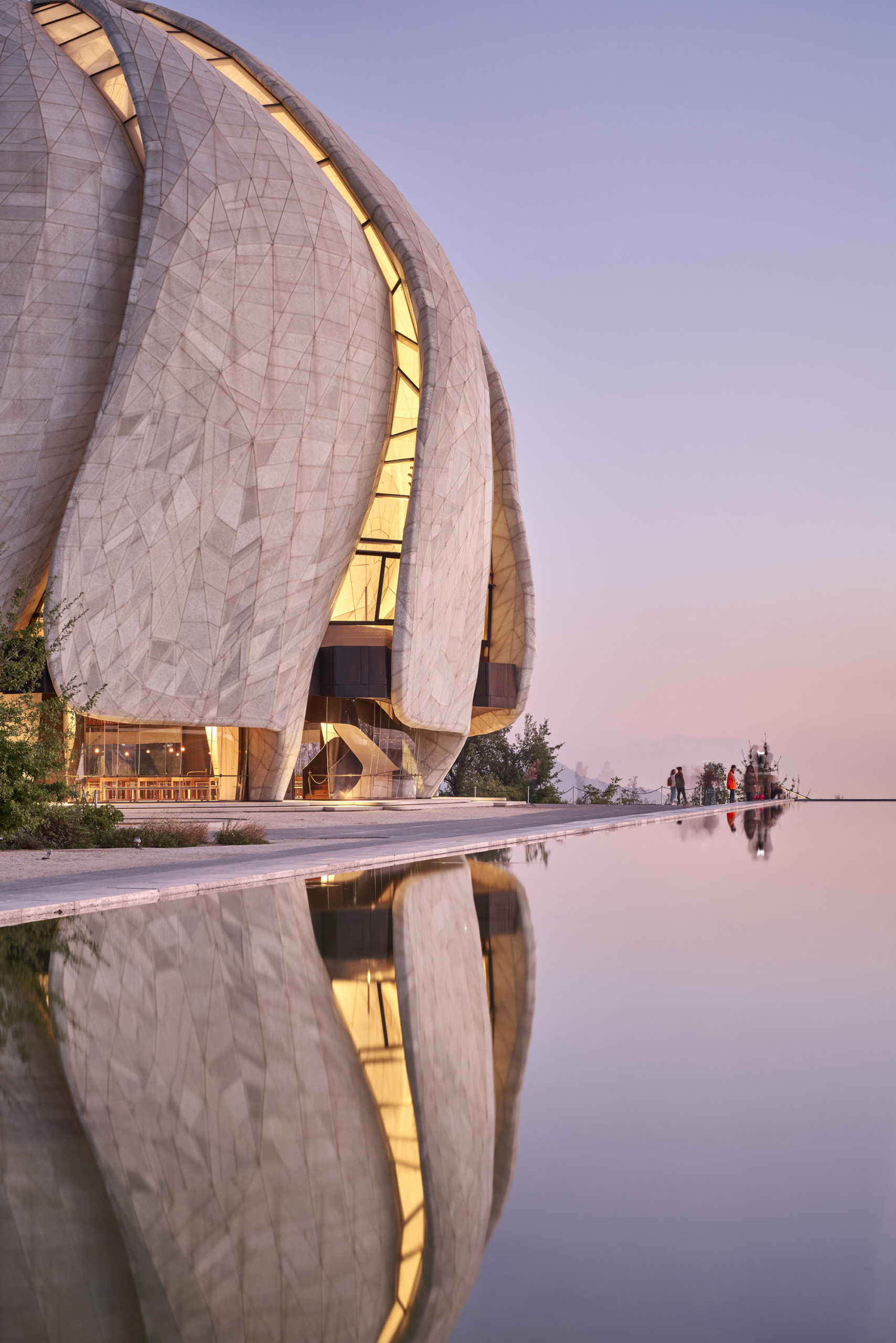
“But the Temple went beyond the community,” he continues. “It extended the principles of the Bahá’í Faith—that every person is equal, that every person can come here to reflect and regenerate. It had this impact that rippled beyond the community and attracted more and more people from all walks of life.”
The process of selection was rigorous and extended over six months. Jury members were asked to perform site visits as part of their research and selection process. “We asked Stephen Hodder, former President of the Royal Institute of British Architects and guest Juror, to visit this project,” says Mr. Nash. “We thought he would have a dispassionate eye.”
Mr. Hodder visited the Temple for three days earlier this year and spent a significant amount of time with the local community. He later shared his impressions with the Jury, referring to the House of Worship as “truly transformational, timeless and spiritual architecture, the like of which I have never experienced, and the influence of which extends way beyond the building.”
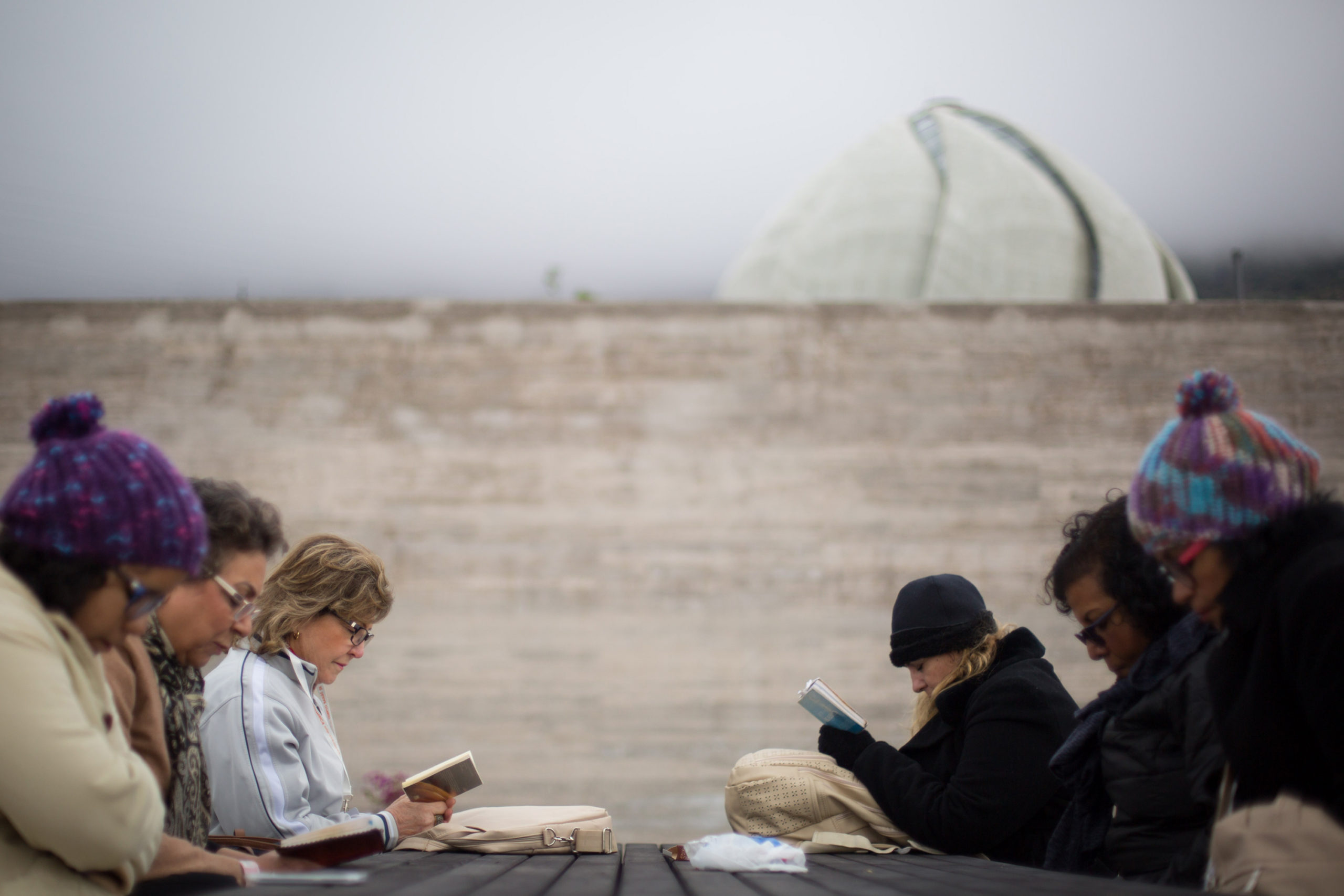
Speaking about Mr. Hodder’s visit, Mr. Nash says “Stephen said to me that he had not felt such an emotional impact since he had walked into Ronchamp, which is a very famous chapel all of us have visited in our architectural careers. It is a touchstone of modern architecture. He said ‘this goes beyond Santiago, it reaches out to the world.’”
Mr. Hodder in his comments to the Jury shared the following thoughts:
“How can it be that a building captures the spirit of ‘unity,’ a sacred place, or command a prevailing silence without prompting? The interior space spirals upwards vortex-like culminating with the oculus within which is the inscription ‘O Thou Glory of the Most Glorious’. Seating orientates to Haifa and the Shrine of the Báb, the forerunner of Bahá’u’lláh…. But why do people flock to the Bahá’í Temple? Is it the garden, planted with native species and lovingly cared for by volunteers, or the view over Santiago and remarkable sunsets, or the curious object set against the mountains? The Temple is the anchor…At night, the opacity of the cast glass outer skin, and the translucency of the Portuguese marble inverts, and the dome appears to glow ethereally from the inside…. The Temple has not only afforded a focus for the Bahá’í community but in their commitment to ‘service’ also for the neighbourhood and its well being.”
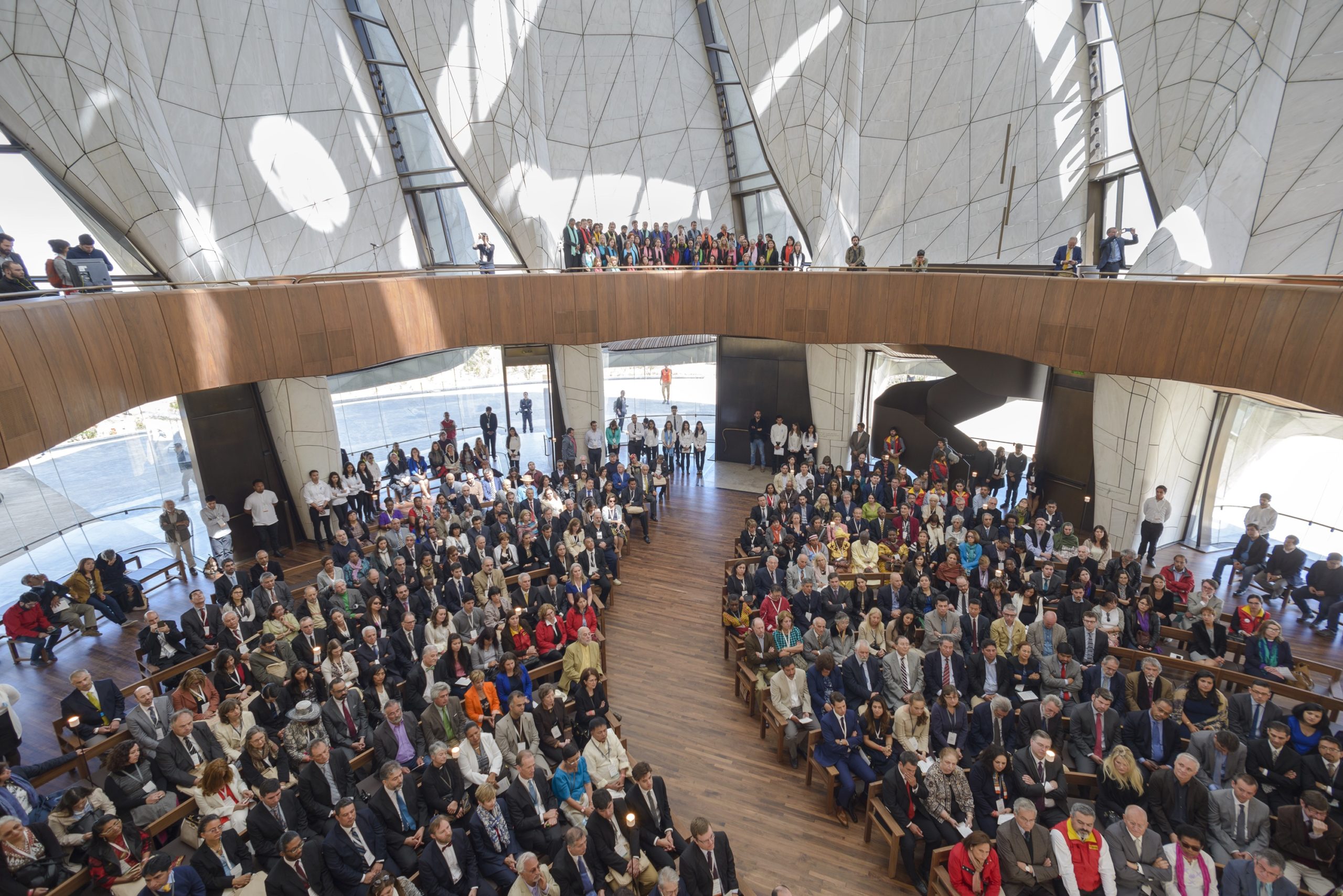
It was not only the impact of the Temple on society but also the nature of its craftsmanship that struck the Jury. “It was lovingly assembled,” says Mr. Nash. “The woodwork, the stonework, and the glasswork—they all have the sense of a hand shaping them, which is remarkable for a project so sophisticated. This had a powerful impact on the Jury. There was this sense that the hand of the community had crafted the outcome.”
In the wake of the award, Mr. Hariri has been reflecting on the endeavour. “Hundreds of people sacrificially worked on this project with great dedication, enormous skill, and put themselves forward at the very frontier of what’s possible in architecture,” he explains.
“The Temple reflects an aspiration. What architects do is put into form aspiration. When you have a chance like this, where the aspirations are so great, it requires the furthest reaches of imagination to meet that challenge.”


The award was presented on 25 October at a ceremony at the Westin Harbour Castle in Toronto. “Above all,” said Mr. Hariri in remarks he made that evening, “our gratitude extends to the Universal House of Justice which was our unwavering source of guidance, courage, and constancy.”
Mr. Nash, who was there, says that as the talk finished people were standing and cheering. “We were all very inspired. It’s a project that has a life of its own. It is supposed to be a building built to last 400 years. I suspect it will go well beyond that.”

Over the past 100 years, the world has witnessed the gradual emergence of a new entity: a collective centre for men’s souls
called the Mashriqu’l-Adhkár.1‘Abdu’l-Bahá, Selections from the Writings of ‘Abdu’l-Bahá, no. 60.1, in The Institution of the Mashriqu’l-Adhkár: A Compilation of Extracts from the Writings of Bahá’u’lláh and ‘Abdu’l-Bahá, the Writings of Shoghi Effendi, and the Letters of the Universal House of Justice, prepared by the Research Department of the Universal House of Justice (September 2017) #16. Available at https://www.bahai.org/library/authoritative-texts/compilations/institution-mashriqul-adhkar/. This dawning place of the mention of God
was created by Bahá’u’lláh,2 In the Kitáb-i-Aqdas, His book of laws, Bahá’u’lláh describes the Mashriqu’l-Adhkár as each and every building which hath been erected in cities and villages for the celebration of My praise, par. 115. In The Institution of the Mashriqu’l-Adhkár #2. and in the Bahá’í writings, the term refers, in different contexts, to gatherings, to structures, and to the institution of the Mashriqu’l-Adhkár3In a letter to an individual believer dated 20 April 1997, the Universal House of Justice wrote, The term ‘Mashriqu’l-Adhkár’has been used in the Writings to describe various things: the gathering of the friends for prayers at dawn; a building where this activity takes place; the complete institution of the Mashriqu’l-Adhkár, with its dependencies; the central edifice of that institution, often described as a House of Worship or Temple. These variants can all be seen as denoting stages or aspects of the gradual introduction of Bahá’u’lláh’s concept as promulgated in the Kitáb-i-Aqdas. In The Institution of the Mashriqu’l-Adhkár #73. See also the letter of the Universal House of Justice to the Bahá’ís of Iran (18 December 2014). —variations that correspond to an evolving understanding and practice of worship
in relation to community development.
The first use of the term, with reference to gatherings, reflects the truth that any group of people in any locality in the world can create the spiritual environment of the Mashriqu’l-Adhkár when they gather together to pray; the second, in conjunction with structures, indicates a dedicated space, an outward frame
that reveals the inward reality
;4‘Abdu’l-Bahá, from a Tablet translated from the Persian, in The Institution of the Mashriqu’l-Adhkár #21. and the third signals the emergence of a formal institution as the inward reality
strengthens and is expressed through action. In fact, ‘Abdu’l-Bahá described the Mashriqu’l-Adhkár as one of the most vital institutions in the world.
5‘Abdu’l-Bahá, Selections from the Writings of ‘Abdu’l-Bahá, no. 64.1. In The Institution of the Mashriqu’l-Adhkár #18. Elaborating on this, the Universal House of Justice refers to it as the focal point of the community from which it emerges
because it not only provides a space for worship but also encompasses dependencies; together, these embody two essential and inseparable aspects of Bahá’í life: worship and service.
6Universal House of Justice, from a letter to the Friends Gathered in Santiago, Chile, for the Dedication of the Mother Temple of South America (14 October 2016). In The Institution of the Mashriqu’l-Adhkár #69.

Worship, in Bahá’í practice, is simple in form and open to all. In devotional gatherings, which the Universal House of Justice has called “seeds of future Mashriqu’l-Adhkárs,”7 In a letter to the Bahá’ís of Iran (18 December 2014), the Universal House of Justice wrote: Beloved friends: Gatherings dedicated to prayer throughout your blessed land, in every neighbourhood, town, village, and hamlet, and the increasing access that your compatriots are gaining to Bahá’í prayers are enabling your community to shine the light of unity in the assemblage of humanity, lending a share to the endeavours of your fellow believers throughout the world. Plant, then, the seeds of future Mashriqu’l-Adhkárs for the benefit of all, and ignite countless beacons of light against the gloom of hatred and inequity. In The Institution of the Mashriqu’l-Adhkár #67.any soul may enter, inhale the heavenly fragrances, experience the sweetness of prayer, meditate upon the Creative Word, be transported on the wings of the spirit, and commune with the one Beloved.8Universal House of Justice, from a letter to the Conference of the Continental Boards of Counsellors (29 December 2015). In The Institution of the Mashriqu’l-Adhkár #68. In a Mashriqu’l-Adhkár, worship is likewise without ritual or set patterns, and the object is the same. As Shoghi Effendi wrote, “the more universal and informal the character of Bahá’í worship in the Temple the better.”9From a letter written on behalf of Shoghi Effendi to the National Spiritual Assembly of the United States and Canada (11 April 1931). In The Institution of the Mashriqu’l-Adhkár #45. Sacred scriptures from the Bahá’í Faith and other religions are read or chanted; there is no sermon or lecture, no collection of funds, no instrumental music, and no segregation for any reason such as sex, religion, or caste. Likewise, as service to humanity is an element of Bahá’í life in communities everywhere, no matter what their size or means, in communities where a Mashriqu’l-Adhkár emerges, the purpose of its dependencies is to systematize the facilitation of service to the common good by providing “centres of education and scientific learning as well as cultural and humanitarian endeavour” and by promoting the application of knowledge “to serve social and spiritual progress.”10Universal House of Justice, from a letter to the Bahá’ís of Iran (18 December 2014). In The Institution of the Mashriqu’l-Adhkár #67. Crucially, these two aspects of worship and service cannot be isolated from each other. Until “translated and transfused”into “dynamic and disinterested service to the cause of humanity,” the results of worship are limited;11Shoghi Effendi, from a letter to the beloved of the Lord and the handmaids of the Merciful throughout the United States and Canada (25 October 1929), in Bahá’í Administration: Selected Messages 1922–1932 (Wilmette: Bahá’í Publishing Trust, 1974, 1998 printing), 184–86; in The Institution of the Mashriqu’l-Adhkár #38. the dependencies of the Mashriqu’l-Adhkár both promote this change and provide channels for it.

The physical and organizational structures associated with the Mashriqu’l-Adhkár emerge organically as understanding matures and a community develops the capacity for effective action. Because the physical structure provides a space for a growing number of people to gather to worship and to serve the broader community, it is important that the space created be welcoming to all. Therefore, the physical requirements, like the practice of worship inside the Mashriqu’l-Adhkár, are simple: It must have nine sides with nine entrances, signaling its openness to all. Inside, there are no pulpits or altars, and no pictures, icons, or statues. Most importantly, it should be beautiful and “as perfect as is possible in the world of being,”12Bahá’u’lláh, The Kitáb-i-Aqdas: The Most Holy Book, par. 31. In The Institution of the Mashriqu’l-Adhkár #1. so as to act as a means of “nurturing an attraction to the sacred.”13Universal House of Justice, on the occasion of the dedication of the House of Worship in Santiago, Chile (14 October 2016). Furthermore, the design should be integrated with the culture of its location—a feature amply demonstrated in the diversity of the Houses of Worship that have been constructed to date.14Designs have been diverse and innovative. In some cases, the architects have been told that what they have been envisioned is impossible—and yet they have achieved it. For example, in Chicago, the architect’s design resulted in engineering innovations in the use of concrete; in Germany, the modern design immediately distinguished this place of worship from traditional structures associated with other faiths. In India, the architect chose the motif of the lotus flower, a sacred symbol that resonates with the population irrespective of religious affiliation; Apia’s Temple is based on the open design of a traditional Samoan meeting house, and Panama’s open design incorporates indigenous motifs in the supporting brickwork. Many of the designs have won awards for their engineering and design innovations. In locations where local Houses of Worship are planned or have been recently constructed, the Bahá’í community has entered into a consultative process with the local population to generate a sense of ownership by all.15These consultative meetings have addressed topics such as the building design and the surrounding gardens. In Norte del Cauca, this brought about a plan to restore native species of plants and trees that had largely disappeared from the region.
Beginnings: ‘Ishqábád and Chicago
Ten Mashriqu’l-Adhkárs currently exist throughout the world. The first eight were built to serve as continental-level Temples in Chicago, the United States of America, for North America; Kampala, Uganda, for Africa; Sydney, Australia; Frankfurt, Germany, for Europe; Panama City, Panama, for Central America; Apia, Samoa, for Australasia; New Delhi, India; and Santiago, Chile, for South America. Local Houses of Worship have been completed in Battambang, Cambodia, and in Agua Azul, in the Norte del Cauca region of Colombia. Five more are in some stage of development: two national-level Temples in Papua New Guinea and the Democratic Republic of the Congo, and three more local Houses of Worship in Tanna, Vanuatu; Bihar Sharif, India; and Matunda Soy, Kenya. The determination as to where and when one will take physical shape in a community is made by the Head of the Faith and corresponds to that Bahá’í community’s capacity to embrace both the spiritual and practical aspects associated with it—to engage in sustained, long-term action to assist large numbers of people in a process of transformation that is both individual and collective, spiritual and material. The Bahá’í world community is still at the beginning of this temple-building process, but a look at how the world’s first two Bahá’í Houses of Worship took shape over a century ago offers some insights as to how this unique institution can develop in widely differing matrices and provides some historical context for the current efforts to construct national and local Mashriqu’l-Adhkárs.
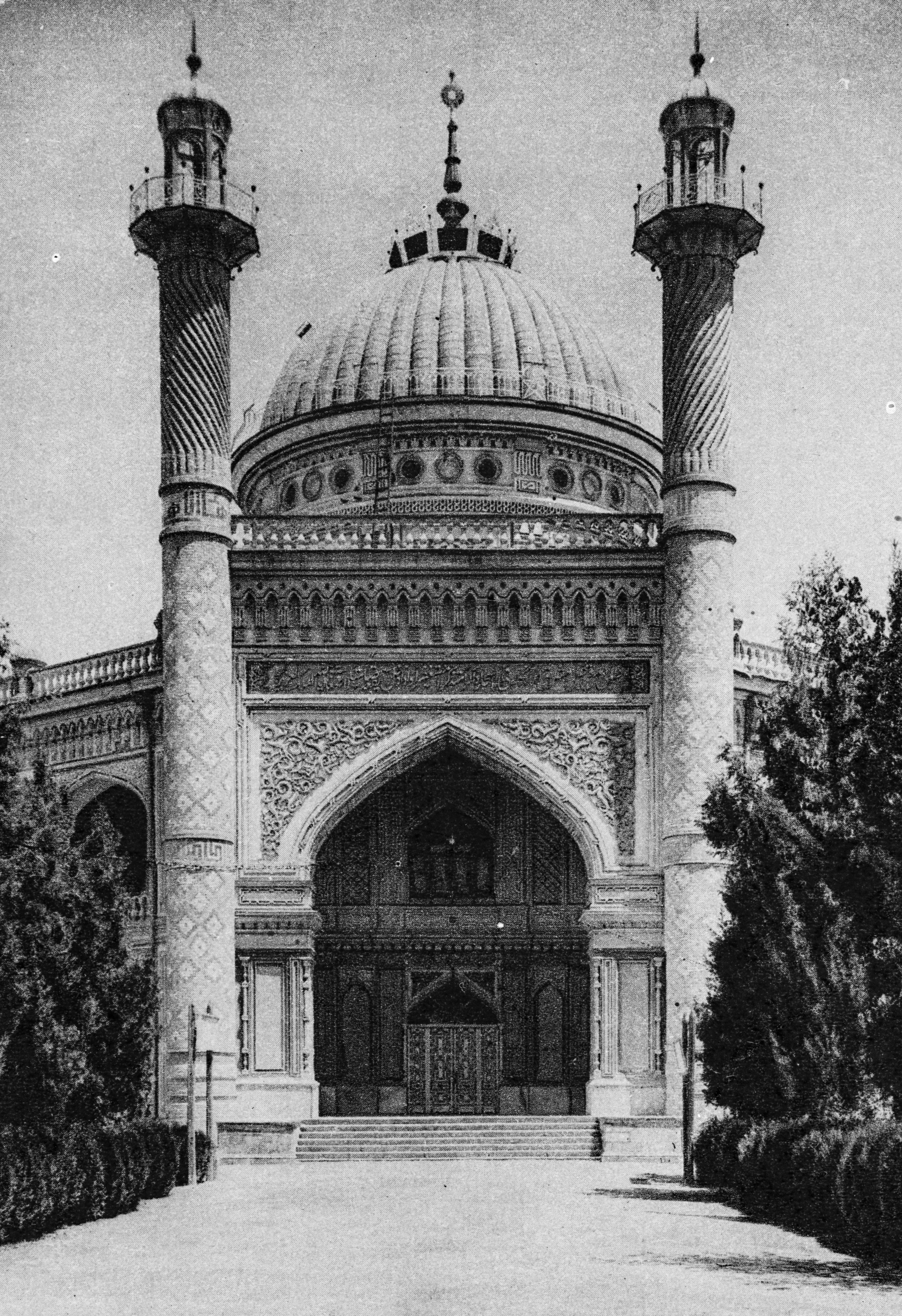
The world’s first Bahá’í House of Worship was built in ‘Ishqábád16Alternate transliterations are Ashgabat or Ashkhabad.in the Russian Transcaspian province close to the border of what is present-day Iran, where a small group of Persian Bahá’ís had settled to escape persecution in their home country. The first few adherents arrived around 1884; by 1890, there were some 400 and by 1902, approximately 1,000. As early as 1887 they acquired land and began to develop facilities for communal well-being,
including a meeting hall, schools for both boys and girls, a travelers’ hospice, and a clinic—all of which were established in an environment of unified endeavour and progress.
17Universal House of Justice, from a letter to the Bahá’ís of the World (1 August 2014). In The Institution of the Mashriqu’l-Adhkár #66. Significantly, Bahá’u’lláh Himself approved the land for the project. Later, acting on directions from ‘Abdu’l-Bahá, the community commenced construction on the Mashriqu’l-Adhkár in 1902.
One writer’s description conveys the organic nature of the process through which the House of Worship emerged: …they purchased a piece of ground, made it a beautiful garden, held open air meetings in the summer time; and when they could, erected a frame structure, which was used as a school for the Bahai children during week days; until finally—nine years after the ground was purchased, … they commenced the edifice ….
18Cited in R. Jackson Armstrong Ingram, Music, Devotions, and Mashriqu’l-Adhkár, Studies in Bábí and Bahá’í History (LA: Kalimat Press, 1987), 127. It is significant that the starting point of the community’s effort to develop its Mashriqu’l-Adhkár was by raising the level of the community’s social and economic development—notably, eliminating illiteracy by establishing educational facilities for all the children.
While the Bahá’í community of ‘Ishqábád achieved a high degree of internal unity, the wider social environment was not widely accepting of—and was, in some cases, openly hostile to—the teachings of the new faith. Thus, the spiritual encouragement and material support that the community received from elsewhere were doubly important. The Bahá’ís there must have been heartened by ‘Abdu’l-Bahá’s promise that such a material structure
would have a spiritual effect
and a powerful influence on every phase of life
19‘Abdu’l-Bahá, Selections from the Writings of ‘Abdu’l-Bahá 60.1. In The Institution of the Mashriqu’l-Adhkár #16. and by His assertion that He longed to participate in the construction Himself.20In one letter, He wrote: Were ‘Abdu’l-Bahá not imprisoned and were there not obstacles in his path, he himself would assuredly hasten to ‘‘Ishqábád and carry the earth for the building of the Mashriqu’l-Adhkár with the utmost joy and gladness. ‘Abdu’l-Bahá, cited in a letter from the Universal House of Justice to the Bahá’ís of the World (1 August 2014). As the work neared completion, ‘Abdu’l-Bahá wrote that the news had brought him infinite joy
and declared that it would become a place of great happiness,
without peer or likeness.
21‘Abdu’l-Bahá, from a Tablet translated from the Persian. In The Institution of the Mashriqu’l-Adhkár #24.
In this great building project, the Bahá’í community of ‘Ishqábád was fortunate to have the support of an individual who sacrificially contributed a significant portion of the funds,22His name was Hájí Mírzá Muhammad-Taqí Afnán. ‘Abdu’l-Bahá’s tribute to him can be found in Memorials of the Faithful (Wilmette: US Bahá’í Publishing Trust, 1971), 126–29. In it, He extolls him as the first builder of a House to unify man, 128. ut while his generosity was instrumental, the Bahá’í community as a whole was also directly involved, which allowed it to develop capacity to administer the affairs of the local Bahá’í community in an atmosphere of unified purpose. 23It is important to note that only members of the Bahá’í community have the privilege to contribute to the Bahá’í funds and thus support the construction of a House of Worship. As ‘Abdu’l-Bahá wrote: The friends in ‘Ishqábád made the raising up of the Mashriqu’l-Adhkár the means of creating perfect fellowship. With the utmost love and sincerity, they elected a committee, and that committee attended to establishing, organizing, arranging, and designing the Mashriqu’l-Adhkár,
which was constructed in great soundness and majesty.
24‘Abdu’l-Bahá, from a Tablet translated from the Persian. In The Institution of the Mashriqu’l-Adhkár #20.
Through this focus, fortified by ties of camaraderie and animated by unity of purpose and a spirit of faithfulness,
the community reached a high degree of cohesiveness and development,
and its members became distinguished for their prosperity, magnanimity, and intellectual and cultural attainments.
25The Universal House of Justice, letter to the Bahá’ís of the world, 1 August 2014. Available at https://www.bahai.org/library/authoritative-texts/the-universal-house-of-justice/messages/20140801_001/1#980781985. In The Institution of the Mashriqu’l-Adhkár #66. One writer estimates that ‘Ishqábád was the first place where there was a conscious attempt to build up a Bahá’í community along the pattern laid down in the Bahá’í writings,
noting, Nowhere else was there both the numbers of Bahá’ís and the freedom sufficient to do this. In Iran, the numbers existed but not the freedom. Elsewhere in the Middle East, the numbers were not sufficient.
26Moojan Momen, The Bahá’í Community of Ashkhabad: Its Social Basis and Importance in Bahá’í History, in Cultural Change and Continuity in Central Asia. Ed. Shirin Akiner. (London: Kegan Paul, 1991), 300. http://www.momen.org/relstud/’Ishqábád.htm. Central to this development was the community’s rich pattern of life deriving its impetus from the power of the Creative Word
27The Universal House of Justice, letter to the Bahá’ís of the world, 1 August 2014.—a pattern that was ultimately given communal space in the House of Worship.

The initial challenge that the Bahá’í community of ‘Ishqábád faced was external opposition from Shi’ih Muslims. In 1890, for example, a prominent member of the Bahá’í community was murdered in the marketplace in full view of some 500 spectators who cheered the murderers on.28For accounts of this episode and its consequences, see Shoghi Effendi, God Passes By. First edition published 1944. Revised edition 1974 (Wilmette: Bahá’í Publishing Trust, 1974), 202–03; Nancy Ackerman and Graham Hassall, Russia and the Bahá’í Faith: A Historic Connection, The Bahá’í World 1998–99 (Haifa: Bahá’í World Centre, 2000), 162; Momen, 282–83. Fortifying itself to withstand such opposition and flourishing under the guidance of ‘Abdu’l-Bahá, the community became very unified, but its growth was limited—generated largely by the arrival of additional members from Iran. Following the Russian Revolution, the community faced further difficulties owing to the government’s anti-religious policies, and ultimately its life span was cut short. By 1938 the authorities had prohibited its activities, seized its properties, converted them to other uses, and exiled many of the members. The House of Worship itself was expropriated, used as a museum until it was damaged in an earthquake, and eventually demolished.29For more details, see Houses of Worship around the World: Ashgabat (Ashkhabad, ‘‘Ishqábád) in The Bahá’í Encyclopedia Project, www.bahai-encyclopedia-project.org. Nevertheless, its brief existence and the Bahá’í community’s efforts to construct a pattern of life that translated worship into active service to humanity stand as a powerful example to later generations.
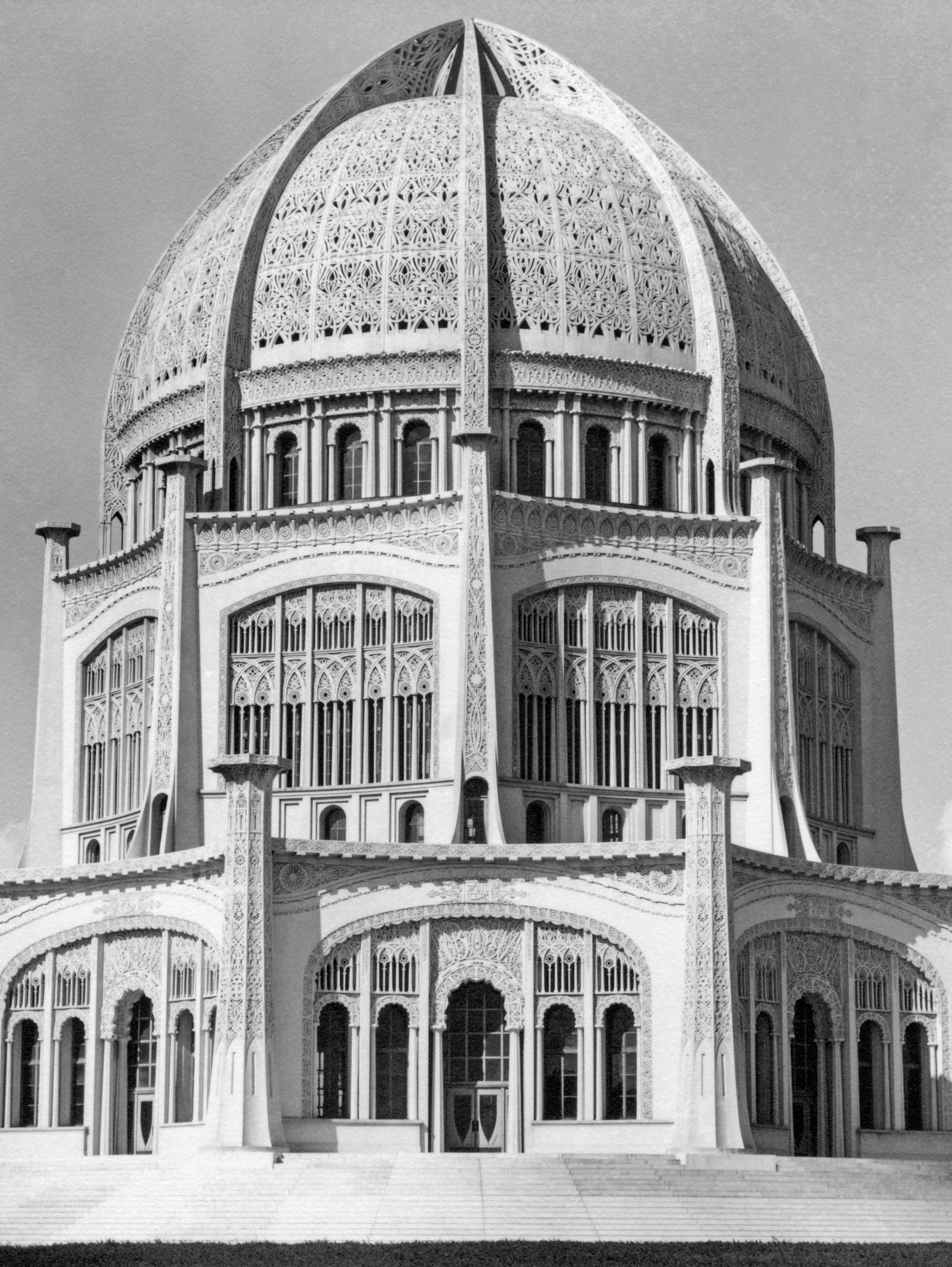
The process through which the construction of the world’s second Bahá’í House of Worship was undertaken was quite different. In 1903, learning about the initiative in ‘Ishqábád, a group of Bahá’ís in the Chicago area petitioned ‘Abdu’l-Bahá for permission to build a Mashriqu’l-Adhkár and received warm encouragement to undertake the project. However, the American matrix generated very different dynamics. As one author puts it, Although there had grown a substantial Bahá’í community in Chicago and although these Bahá’ís did in 1903 decide to build a House of Worship in emulation of the Ashkhabad House of Worship, there was not the same unity and community spirit nor the resources to equal the Ashkhabad achievements.
30Momen, 300.
While there was no external opposition to contend with, a number of geographic and cultural factors served as impediments. First, in contrast to the community in ‘Ishqábád, the North American Bahá’í community was composed of recent converts whose access to Bahá’í scripture was limited and whose new faith was tested by the falling away of the first teacher in North America. Second, the Bahá’ís lived in comparatively small and widely scattered centers throughout the continent—some 150 cities by 1906, but the communities were mostly modest in size and were spread throughout eleven states as well as the city of Montreal, in Canada.31Bruce Whitmore, The Dawning Place: The Building of a Temple, the Forging of a Global Religious Community, 2nd ed, revised and expanded (Wilmette: Bahá’í Publishing, 2015), 25. A third challenge to their unity arose from their culture’s prizing of individualism above collective endeavor, and a fourth came from gender inequality.
While the idea of building a Temple generated enthusiasm among many when it was first raised by the Bahá’í community in Chicago, there was also some confusion. What would be its scope? Some saw it as a local Mashriqu’l-Adhkár similar to the one they had read about in ‘Ishqábád, and a number of other communities immediately proposed building one of their own. However, ‘Abdu’l-Bahá swiftly guided them to think of the Chicago House of Worship not only as a national but as a continental effort that should be supported by Bahá’í communities throughout North America and around the world, especially those in Iran.
Establishing a climate of unity was hard work. Some objected to providing funds for a House of Worship in a distant location. Others resisted the call to support the Temple project because a woman, Corinne True, was initially one of the strongest forces behind it after being assigned the task by ‘Abdu’l-Bahá. Difficulties arose in reaching agreement about the site and the Temple design. Eventually, however, a parcel of land in Wilmette, north of Chicago, was agreed upon, and the cornerstone was laid by ‘Abdu’l-Bahá in 1912 during His visit to North America—a moment of great joy and triumph for the community. Nevertheless, decades of fundraising followed, and other challenges had to be surmounted before the project’s completion.
Its efforts to overcome these difficulties shaped the North American Bahá’í community. The construction of the Temple was, in the words of the Universal House of Justice, a complex project
that took decades to complete, through two world wars and a widespread economic depression
with each stage in its development … intimately tied to the expansion of the community and the unfoldment of its administration.
32The Universal House of Justice, letter to the Bahá’ís of the world, 1 August 2014. Throughout this process, the loving and infallible guidance of ‘Abdu’l-Bahá and Shoghi Effendi served as a catalyst for the community’s development by repeatedly raising its vision above the merely material. Shoghi Effendi stressed that It is devotion, sincerity and genuine enthusiasm which in the long run can ensure the completion of our beloved Temple. Material considerations, though essential, are not the most vital by any means.
33From a letter written on behalf of Shoghi Effendi to an individual believer (30 December 1933). In The Institution of the Mashriqu’l-Adhkár #48.
Ultimately, the tests of unity were overcome; institutions were established, matured, and learned how to function more and more effectively as they built both the Temple and a vibrant national community. As one writer has noted, The real strength of the early American believers, men and women, was not that they were like-minded individuals who formed a harmonious, homogeneous community, but that despite their strong individualism they allowed the teachings of Bahá’u’lláh and the guidance of ‘Abdu’l-Bahá to serve as beacons, as sources of inspiration and understanding, as they struggled to build a community that drew its unity from its diversity.
34Whitmore, 28. This is a key achievement of the North American Bahá’ís through their temple-building project.
Time and again, the Guardian, Shoghi Effendi, told the Bahá’ís of North America that no other House of Worship would ever possess the vast, the immeasurable potentialities with which this Mother Temple of the West, established in the very heart of so enviable a continent, and whose foundation stone has been laid by the hand of the Center of the Covenant Himself, has been endowed.
35Shoghi Effendi, letter to the Bahá’ís of North America (28 March 1943), This Decisive Hour #108, https://www.bahai.org/library/authoritative-texts/shoghi-effendi/decisive-hour/5#638973491. Two of these immeasurable potentialities, the expansion of the community
and the unfoldment of its administration,
bear a closer look. Unlike ‘Ishqábád, there were no external conditions to limit the growth of the Bahá’í community in the United States, and both ‘Abdu’l-Bahá and Shoghi Effendi linked the temple-building process to the expansion of the Faith. Accordingly, both potentialities were developed conjointly. By 1944, for example, acting on the guidance of the Guardian, the North American community had completed the exterior of the House of Worship and established Bahá’í communities in every state of the United States and every province of Canada. Furthermore, the number of nine-member local Bahá’í councils, called Local Spiritual Assemblies, had doubled on the continent in a period of seven years, and Bahá’í communities were taking root in Central and South America—many supported by Bahá’í pioneers
who moved there from North America.36See Whitmore, 183.
In a letter dated 28 March 1943, the Guardian described the role the House of Worship in North America was destined to play in hastening the emergence of the World Order of Bahá’u’lláh.
37Shoghi Effendi, So Meritorious an Undertaking (28 March 1943) in This Decisive Hour: Messages from Shoghi Effendi to the North American Bahá’ís 1932-1946, #108. Available at https://www.bahai.org/library/authoritative-texts/shoghi-effendi/decisive-hour/5#860561591. Advancement towards this goal is evident from the early years, in the gradual transfer of responsibility for the Temple project from an individual to a collective level. While ‘Abdu’l-Bahá had tasked Corinne True to spearhead the project when she had gone on pilgrimage in 1907, by 1920 He widened the scope of responsibility, counselling that all the affairs
related to the Mashriqu’l-Adhkár are to be referred to the annual Convention
and that Whatever the Convention, with a majority of opinions, decides, must be accepted and executed.
38Cited in Nathan Rutstein, with the assistance of Edna M. True, Corinne True: Faithful Handmaid of ‘Abdu’l-Bahá (Oxford: George Ronald, 1987), 149. Another step towards realizing this vision of the North American Bahá’í community’s role in hastening the emergence of the World Order of Bahá’u’lláh
was the establishment and development of the institution of the Hazíratu’l-Quds (literally, sacred fold
) in concert with the House of Worship. Its purpose was to accommodate the community’s administrative work, serving as the seat of the Bahá’í National Assembly and pivot of all Bahá’í administrative activity in future.
39The Guardian described the function of the Hazíratu’l-Quds as follows: Complementary in its functions to those of the Mashriqu’l-Adhkár—an edifice exclusively reserved for Bahá’í worship—this institution, whether local or national, will, as its component parts, such as the Secretariat, the Treasury, the Archives, the Library, the Publishing Office, the Assembly Hall, the Council Chamber, the Pilgrims’ Hostel, are brought together and made jointly to operate in one spot, be increasingly regarded as the focus of all Bahá’í administrative activity, and symbolize, in a befitting manner, the ideal of service animating the Bahá’í community in its relation alike to the Faith and to mankind in general. Shoghi Effendi, God Passes By, rev ed (Wilmette: US Bahá’í Publishing Trust, 1974), 339–40. Available at https://www.bahai.org/library/authoritative-texts/shoghi-effendi/god-passes-by/24#198460320. acilities for communal well-being
such as those in ‘Ishqábád were not inaugurated until the construction was completed, when Shoghi Effendi called for the erection of the first dependency of the first Mashriqu’l-Adhkár of the western world.
40Shoghi Effendi, Citadel of Faith (Wilmette: US Bahá’í Publishing Trust, 1965), 108. Available at https://www.bahai.org/library/authoritative-texts/shoghi-effendi/citadel-faith/4#662916934. In response to this call, the Bahá’í Home for the Aged was established in 1959; it operated until 2002.
Looking at these first two Bahá’í Houses of Worship in ‘Ishqábád and Chicago allows us to see how differences in context and focus can affect the emergence of this institution and allow for emphasis to be given to one or another aspect, as appropriate to its matrix. In ‘Ishqábád, the Temple arose within the context of a very strong, active and united local community, and dependencies followed an organic course of development since public services, such as those related to the education of both boys and girls, for example, were not available. In Chicago, on the other hand, the Temple served as the catalyst for building unity of vision and purpose in the Bahá’í community of the entire continent of North America, developing its capacities to raise funds, to use the consultative process to achieve unity of thought and action regarding the design, to grow the community of believers attracted to the teachings of Bahá’u’lláh, and to develop administrative structures to guide and channel the energies of the community. Since public education and other services were widely available, Chicago did not devote energy to developing such dependencies; rather, under the guidance of Shoghi Effendi, it focused on building crucial administrative capacities that eventually affected the development and functioning of national and local Bahá’í communities throughout the entire hemisphere. In a sense, one could view the ‘Ishqábád Temple as a model for the emergence of a local House of Worship and the one in Chicago as a model for the continental
Houses of Worship that were established during the stage of temple building upon which the Bahá’í world community next embarked.
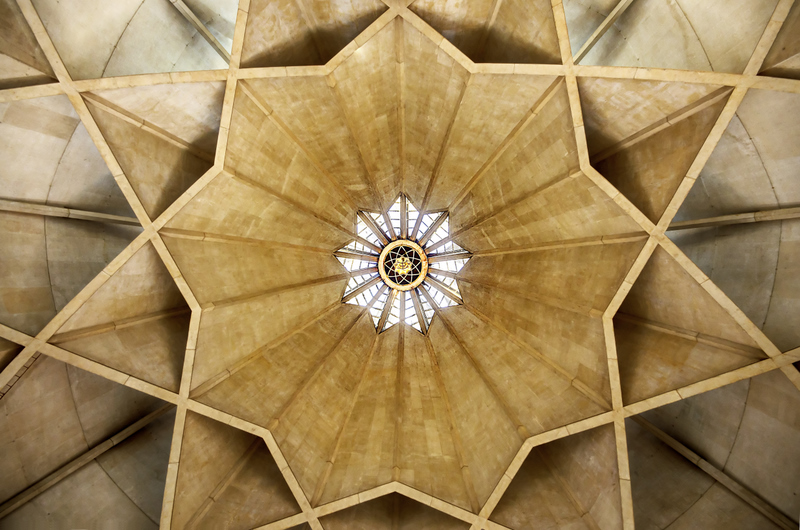
Continental, National, and Local Houses of Worship
With the dedication of the House of Worship in Wilmette in 1953, the Guardian called for the construction of mother temples
on other continents and, as Bahá’í National Assemblies were established in countries around the world, for the acquisition of lands to be used for future national temples. Like the North American House of Worship, these Mashriqu’l-Adhkárs represented beacons—visible manifestations of what will, over time, emerge in countless communities throughout the world. In contrast to the House of Worship in ‘Ishqábád, these continental temples did not emerge from matrices of intense local activity; rather, they represented a vision of worship and service to which emerging national Bahá’í communities in all parts of the world could orient themselves. They emerged over decades, their development guided by Shoghi Effendi and the Universal House of Justice: Africa (Kampala, Uganda) and Australia (Sydney) in 1961, Europe (Langenhain, Germany) in 1964, Central America (Panama City) in 1972, Oceania (Apia, Samoa) in 1984, and the Indian Subcontinent (Bahapur, New Delhi) in 1986. Only the South American Temple remained for many years unbuilt, and it was not until October 2016 that some 3,000 people from around the world gathered in Santiago, Chile, for its dedication—a moment that marked the culmination of a process set in motion over a century before.
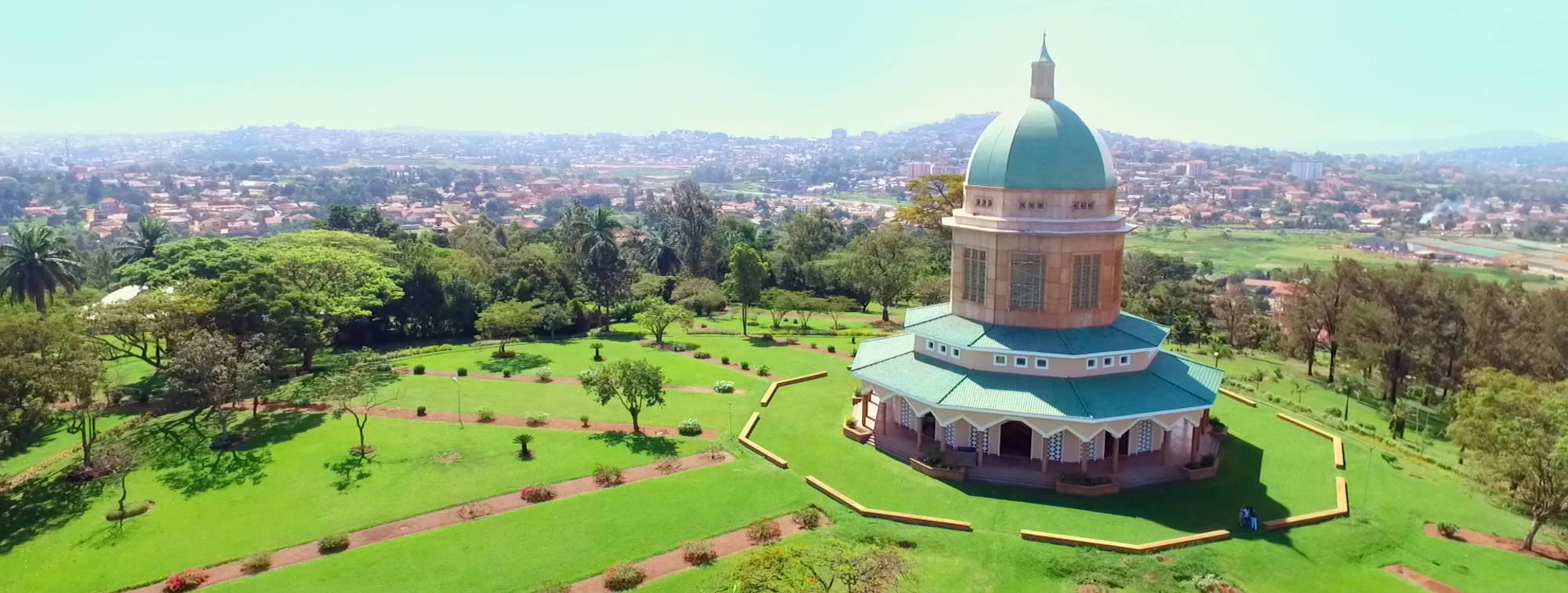

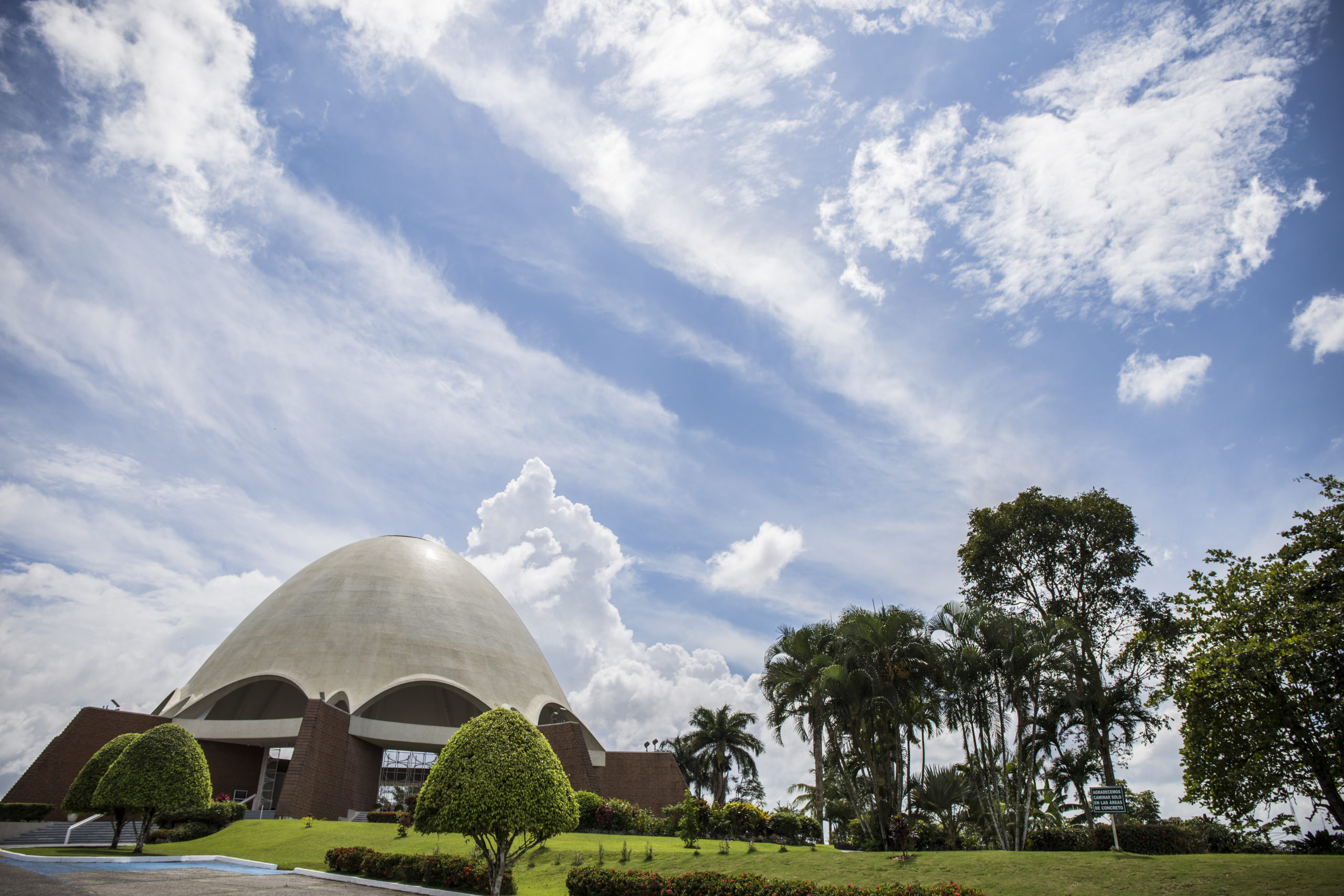
Only the South American Temple remained for many years unbuilt, and it was not until October 2016 that some 3,000 people from around the world gathered in Santiago, Chile, for its dedication—a moment that marked the culmination of a process set in motion over a century before.
By this time, the Bahá’í world community had embarked on a further stage in the development of the institution of the Mashriqu’l-Adhkár. In 2001, in its annual message to the Bahá’í world on the occasion of the Festival of Riḍván, the Universal House of Justice not only announced the construction of this final continental House of Worship, it also heralded the launch of a long-term process of raising up … national Houses of Worship, as circumstances in national communities permit
; 11 years later, at Riḍván 2012, it identified the Democratic Republic of the Congo and Papua New Guinea as the first two sites. This was an historic development, but there was more: in that same message, the House of Justice also announced that the first local Houses of Worship would be constructed in Battambang, Cambodia; Bihar Sharif, India; Matunda Soy, Kenya; Norte del Cauca, Colombia; and Tanna, Vanuatu. Progress on two of these local temples was very swift, and in September 2017—less than a year after the dedication of the final continental House of Worship—the world’s first local Bahá’í Mashriqu’l-Adhkár was dedicated in Battambang; this was followed, in July 2018, by the second, in Norte de Cauca, and plans are currently underway for the construction of the remaining three local and the two national temples.
To explore the reasons why the construction of these national and local Mashriqu’l-Adhkárs is timely and to understand their significance, it is helpful to examine the way they are described by the world-governing body. This will also aid us to reflect how the current process differs from efforts to build places of worship in previous religious dispensations.
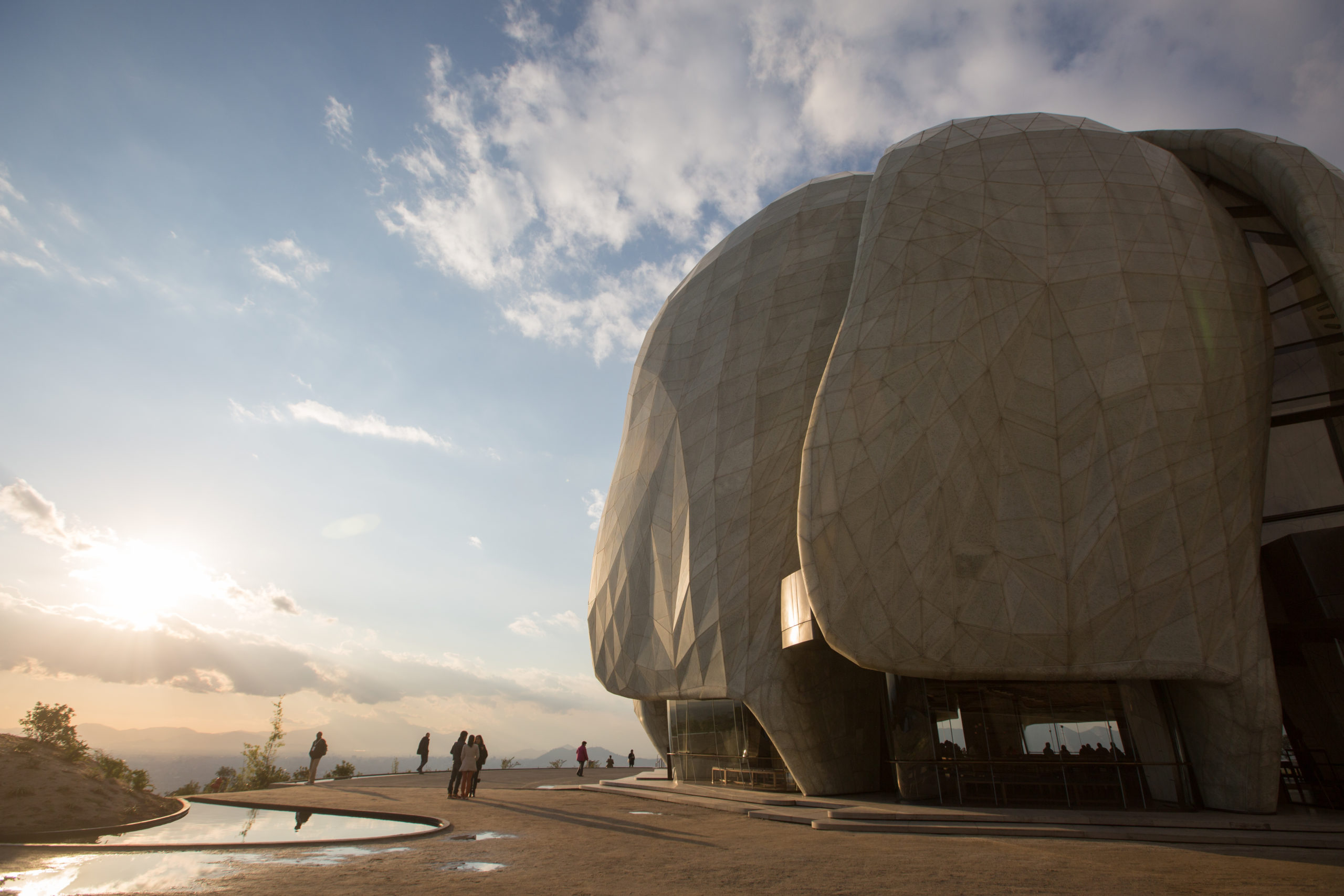
In its message to those gathered for the dedication of the Santiago House of Worship, the Universal House of Justice described how the Bahá’í community in the city, supported by Bahá’ís from other communities throughout North, Central, and South America, learned how to prepare the surrounding population for the emergence of the House of Worship
; this involved developing the capacity to engage increasing numbers of the city’s population to participate systematically in community-building endeavours
and to sustain their actions over time. Through these efforts, visitors began to go to the Temple both to pray and to consult about the practical and spiritual dimensions of the enterprise.
41Universal House of Justice, 1 August 2014. Through such means, construction and grassroots expansion efforts were for the first time united, marking a pivotal point in the global temple-building process.

This emphasis on the preparation of the population for the emergence
of the Temple is related to the processes of growth that have been pursued persistently and unitedly by the Bahá’í world community since 1996 as the latest stage in its global program of expansion and consolidation—processes that can be viewed as the latest stage in a systematic process to spread the teachings of Bahá’u’lláh to all the peoples of the world. From the inception of the Faith, its teachings were carried afar by lone travelling teachers; during the time of ‘Abdu’l-Bahá, efforts became more focused, as individuals arose to travel or pioneer
in the far-flung countries or territories mentioned by Him in His Charter for the expansion of the Bahá’í community throughout the world, the Tablets of the Divine Plan. Under the direction of Shoghi Effendi, the diffusion was further broadened, as Bahá’ís settled and worked to establish communities in many more locations. Over time, these communities have taken root and flourished to the point where, during the past two decades, their members have learned how to effectively engage with friends, neighbors, coworkers, acquaintances, and receptive populations to work with them for the common weal.

In its Riḍván 2012 letter, the Universal House of Justice wrote: … Humanity is weary for want of a pattern of life to which to aspire; we look to you to foster communities whose ways will give hope to the world.
To this end, Bahá’ís have focused on four core
community-building areas: the enhancement of the devotional character of the community, particularly through the holding of gatherings where all are welcome to join in prayer, meditation, and the sharing of inspirational and sacred readings from their own faiths and traditions; the spiritual education of children; a program for the moral and spiritual empowerment of young adolescents; and the study of materials that will develop participants’ capacities to become protagonists themselves in these community-building processes.
Efforts to establish this pattern of life, which the Universal House of Justice describes as a spiritual endeavour, one in which the whole community participates,
42Universal House of Justice, Riḍván 2013. unite both worship and service. Here, one can see the connection to the Mashriqu’l-Adhkár, which, Wherever it is established, … will naturally be an integral component of the process of community building that surrounds it
—an awareness that is growing in localities where Houses of Worship are emerging.43Universal House of Justice, Riḍván 2013. While these core activities are all intertwined, the one that is first encouraged and forms the basis of the eventual emergence of a local House of Worship is the holding of devotional gatherings—its seeds.

In some countries, such as the Democratic Republic of the Congo and Papua New Guinea, these seeds
have grown to the extent that the movement of entire populations toward the teachings of Bahá’u’lláh is becoming evident; thus, giving physical shape to the spiritual reality through the construction of a national House of Worship is timely. And as these teachings penetrate deeper and deeper into the soil of society,
44Universal House of Justice, Riḍván 2012. more national Houses of Worship will emerge. A similar process is visible in some small geographic areas (called clusters
) such as Battambang, Bihar Sharif, Matunda Soy, Norte del Cauca, and Tanna that have facilitated the raising up of great numbers of protagonists in the community-building activities within a concentrated space. As the Universal House of Justice noted at Riḍván 2012, The correlation of worship and service is especially pronounced in those clusters around the world where Bahá’í communities have significantly grown in size and vitality, and where engagement in social action is apparent.
45Universal House of Justice, Riḍván 2012. In such instances, the construction of a House of Worship becomes a logical extension of their efforts.

Clearly, much is being learned through these undertakings, and more will be written about them in the coming years. As such universal places of worship are given shape in more and more communities, providing for all inhabitants a haven for the deepest contemplation on spiritual reality and foundational questions of life, including individual and collective responsibility for the betterment of society
46Universal House of Justice, letter to the Bahá’ís of Iran (18 December 2014). In The Institution of the Mashriqu’l-Adhkár #67. and serving as an integral part of the process of community building,
47Universal House of Justice, letter to an individual believer (12 December 2013). In The Institution of the Mashriqu’l-Adhkár #78. members of the Bahá’í community are aware that ceaseless cooperation and mutual support
as well as sacrifice
must be the hallmark of their efforts.48From a letter written on behalf of Shoghi Effendi to the National Spiritual Assembly of Egypt (14 May 1936), translated from the Arabic. In The Institution of the Mashriqu’l-Adhkár #50. This, they have embraced in a spirit of joy and with a profound commitment to the process, eager to nurture communities of spiritual distinction
49From a letter to the Friends Gathered in Battambang, Cambodia, for the Dedication of the House of Worship (1 September 2017). In The Institution of the Mashriqu’l-Adhkár #70. and to galvanize an entire people to reach for a more profound sense of unified purpose.
50From a letter to the Friends Gathered in Santiago, Chile, for the Dedication of the Mother Temple of South America (14 October 2016). In The Institution of the Mashriqu’l-Adhkár #69.
In Norte del Cauca, the land is blanketed by sugar cane plantations. They run for miles, under the watchful gaze of the Andes.
Scattered amid the expanse of monoculture fields, villages and small farms dot the terrain. In recent decades, these traditional farms and the lush greenery of the region have been largely overtaken by vast fields of sugar cane crop.
Here, in the village of Agua Azul, and in neighboring communities, people have been talking about the revival of the natural habitat. This conversation was catalyzed in April 2012, when it was announced that a Baha’i House of Worship was to be built here for the people of the region.
Over the period since the announcement, as the community has set out to prepare itself for this momentous development, a heightened consciousness of the nature and purpose of the House of Worship has given rise to an acute awareness about the physical environment and its relationship to the spiritual and social well-being of the population.
“There were several meetings early on, when plans for the Temple were announced,” explains Ximena Osorio, a representative of the Colombian Baha’i community. “People were inspired by the concept of the House of Worship, how it brought together devotion and service, how it was to be a place of worship for everyone.”
“Gradually, conversations arose about the types of trees and flowers that would surround the Temple,” says Ms. Osorio. “They wanted the landscape to capture the beauty and diversity of the region.”
Over time, the conversation evolved. “An idea emerged,” continues Ms. Osorio. “We would grow a native forest on the land surrounding the Temple site. ”
The idea took root, and a team coalesced around the project.
Hernan Zapata, affectionately referred to within the community as “Don Hernan”, recently joined the initiative. A traditional farmer from the neighboring village of Mingo, he has worked the land his entire life.
Today, his is one of the remaining traditional farms in the region, and many of the species which are found on his land have all but disappeared in surrounding areas. His land provides a glimpse into the rich ecological diversity that had characterized Norte del Cauca only decades ago.
“The truth is that Norte del Cauca was once an immense forest,” explains Don Hernan. “But all of that has been destroyed. Now none of it exists.”
“One thing I want with this project,” he explains, “is that new generations should know what once existed. This native forest that we are going to grow should be a school, should be a place of learning.”

The project has captured the imagination of many others in the region as well. Throughout neighboring villages, individuals have begun to donate seeds and plants that can be grown on the land around the Temple site and in a greenhouse that has been built for the project by local volunteers.
Contributions have included indigenous species, such as the rare “Burilico” tree, which is near extinction in the region.

For Gilberto Valencia, a local factory worker and member of the project team, this initiative has connected him to his family history in Norte del Cauca.
“I’ve always been very motivated to know more about the land and about farming because, while I am not a farmer, I come from a long line of farmers. My father and his father always had a farm that they cultivated for the subsistence of the family, and for the sale of goods to others.”
The project inspired Mr. Valencia, who is married and a father, to begin studying environmental engineering.
“When I began working on the land surrounding the House of Worship, I felt at that moment, that the thing that we were going to build was going to change the natural environment,” he said. “This is a chance to change the destiny of the region.”
Mr. Valencia now works on the project alongside his ten year old son, Jason, the project team’s newest and youngest member.
In recent months, Jason has found himself immersed in the project, helping to transplant seeds and saplings to the temple site and working alongside his father to cultivate and protect the surrounding land.
“I have learned about trees I never knew existed,” says Jason, speaking about his experience. “I love working with my father on this project because, together, we’re going to revive many of the plants that have been lost.”
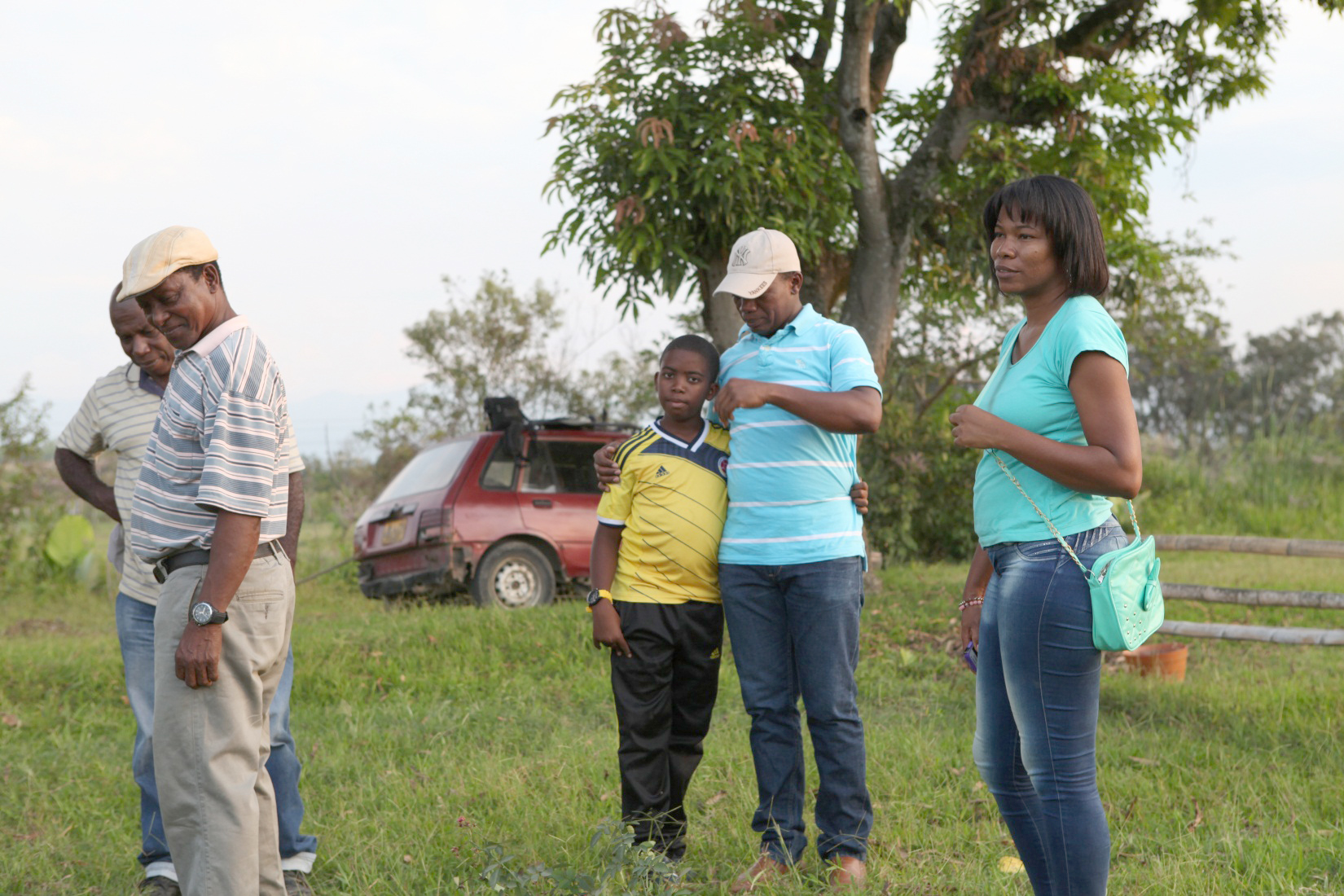
For Alex Hernan Alvarez, a resident of Agua Azul and member of the project team, what is happening in the village has profound implications for the children.
“Here, in Norte del Cauca, we don’t have land or spaces like this, open for everyone. I have three children, and it is very gratifying for me to think that I will leave something for them,” says Mr. Alvarez.
“Knowing that a verdant forest and magnificent House of Worship will bloom for future generations inspires in me a profound sense of dedication.”
Speaking of one of the indigenous trees of the region – the ‘Saman’ tree – Mr. Alvarez states, “The Saman is a traditional tree, beautiful and large. When my children go to the land to pray, they will have a place to sit, under that tree. This motivates me every day. This brings me joy.”
While the House of Worship is not yet built, in many important ways, it is already carrying out its purpose, inspiring the inhabitants of the region to connect with the sacred and reach for greater heights of service to their communities.

“The idea of the Temple, what it represents,” says Ms. Osorio, “is in itself cultivating in all of us – children, youth and adults – an appreciation for the importance of a life centered around worship of God and service to humanity.”